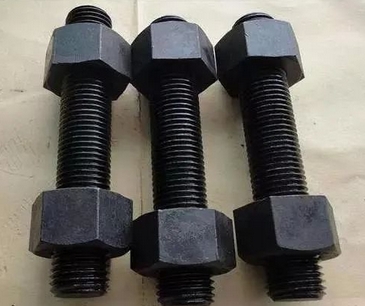
Double-Ended Bolts, also known as studs or double-ended bolts, are used for fixing connections in machinery. Both ends of the double-ended bolt have threads, and the middle shank can be thick or thin. They are commonly used in mining machinery, bridges, automobiles, motorcycles, boiler steel structures, crane towers, large-span steel structures, and large buildings.
01 Basic Introduction
Bolts refer to screws with a larger diameter and can sometimes be without a head, such as double-ended bolts. Generally, they are not referred to as "double-ended bolts" but as "double-ended studs." The most common form of double-ended stud is one with threads at both ends and a plain shank in the middle.
The most typical applications include: Anchor bolts or similar applications where thick connections cannot be achieved with ordinary bolts.
02 Specification Marking
The complete marking for a double-ended bolt with thread specification d=M12, nominal length L=80mm, and performance grade 4.8 is: GB 901 M12×80.
03 Main Applications
Used in large equipment where attachments need to be installed, such as sight glasses, mechanical seals, gearbox frames, etc. In this case, the double-ended bolt is used, with one end screwed into the main body and the other end with a nut. Since the attachment is often removed, the thread can wear or damage, and it is very convenient to replace it with a double-ended bolt.
Used for connecting thick plates where the bolt length is very long.
Used for connecting thick plates and areas where hexagonal bolts are not suitable, such as concrete roof trusses, roof beams, and hanging single rail beam hangers.
04 Purpose of Anti-loosening
In actual work, external loads such as vibration, changes, and material high-temperature creep can reduce friction, leading to a momentary loss of normal pressure in the thread pair and zero friction, causing the threaded connection to loosen. Over time, the threaded connection will loosen and fail. Therefore, anti-loosening measures are necessary to prevent accidents.
05 Surface Treatment
Double-ended bolts generally require surface treatment. The types of surface treatment are numerous, with common methods including electroplating, blackening, oxidation, phosphating, and non-electrolytic zinc coating. However, electroplated fasteners occupy a large proportion in actual use, especially in the automotive, tractor, home appliance, instrumentation, aerospace, and telecommunications industries.
For threaded fasteners, it is not only required to have certain anti-corrosion capabilities but also to ensure the interchangeability of threads, which can also be referred to as thread compatibility. To meet the dual performance requirements of "anti-corrosion" and "interchangeability" for threaded fasteners in use, it is necessary to establish special electroplated layer standards.
GB/T5267.1-2002 [Threaded Fasteners Electroplated Coating] is one of the national standards for "Fastener Surface Treatment" series. This standard includes: GB/T5267.1-2002 [Fasteners Electroplated Coating]; GB/T5267.2-2002 [Fasteners Non-electrolytic Zinc Coating]. This standard is equivalent to the international standard ISO4042;1999 [Threaded Fasteners Electroplated Coating]. This standard replaces the GB/T5267-1985 [Threaded Fasteners Electroplated Coating] standard.
06 Basic Knowledge and Maintenance
The production of double-ended bolts requires fixed equipment and machine tools for processing, which is relatively simple. The main processes include:
Straightening the material with a straightening machine.
Cutting the straightened material to the required length according to customer requirements. Rolling the threads on the cut material using a thread rolling machine.
Double-ended bolts are used in large equipment like gearbox frames. In practical applications, external loads and temperature changes can cause the friction to decrease, leading to threaded connection loosening over time. Therefore, regular maintenance of double-ended bolts is necessary.
Double-ended bolts or anchor bolts may encounter issues under long-term mechanical friction. When problems arise, the engine oil pan should be disassembled, and the condition of the engine crankshaft bearing should be checked carefully.





 Customer service 1
Customer service 1  Customer service 2
Customer service 2